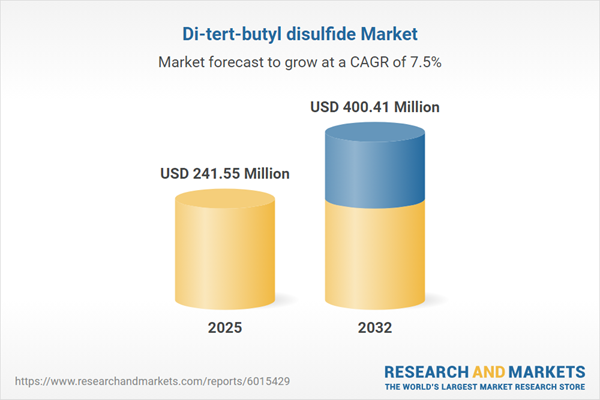Speak directly to the analyst to clarify any post sales queries you may have.
The di-tert-butyl disulfide market is evolving rapidly as senior leaders focus on innovation, regulatory alignment, and navigating global supply networks. Strategic insight and agile planning are essential for organizations aiming to secure enduring growth and operational stability.
Market Snapshot: Di-tert-Butyl Disulfide Market Performance
The global di-tert-butyl disulfide market is forecast to expand from USD 224.34 million in 2024 to USD 241.55 million by 2025, ultimately reaching USD 400.41 million by 2032, reflecting a CAGR of 7.51%. This growth is fueled by widespread industrial adoption, evolving regulatory frameworks, and shifts in global trade policy. Industry players are re-examining procurement and sourcing to remain both stable and flexible in a dynamic business environment. Responsive leadership ensures a competitive edge and resilient, dependable supply chains.
Scope & Segmentation
This report delivers actionable insights for senior executives through detailed analyses of market segments and underlying trends that shape strategic and operational decisions:
- Application: Covers antioxidant additives, organic synthesis, petroleum formulations, and polymerization acceleration, demonstrating their significance in enhancing fuel systems, lubricants, polymers, and rubber manufacturing efficiency.
- End Use Industry: Explores usage within chemical manufacturing, oil refining, pharmaceuticals, polymer, and rubber industries. This provides essential context for addressing sector-specific performance metrics and compliance requirements in sourcing and production.
- Purity Grade: Examines demand variations for high-purity, laboratory, and technical grades, clarifying procurement priorities and the need for strict adherence to product quality and regulatory consistency in B2B transactions.
- Sales Channel: Details direct sales, distributor collaborations, and digital channel strategies, highlighting how distribution methods broaden market reach and strengthen engagement with diverse buyer groups worldwide.
- Geographic Regions: Considers market drivers, local trends, and investment priorities across the Americas, Europe, Middle East & Africa, and Asia-Pacific, equipping leaders to target growth and adapt to regional nuances.
- Key Companies: Benchmarks major brands, including Merck KGaA, Thermo Fisher Scientific Inc., Tokyo Chemical Industry Co., Ltd., BASF SE, Eastman Chemical Company, Evonik Industries AG, Spectrum Chemical Manufacturing Corp., Chemische Fabrik Karl Bucher GmbH & Co. KG, Huntsman Corporation, and Albemarle Corporation to support partnership and competition analysis.
Key Takeaways for Senior Decision-Makers
- Di-tert-butyl disulfide underpins performance and reliability in fuel, lubricant, and polymer applications, helping businesses achieve demanding operational standards.
- Technology upgrades in manufacturing, such as streamlined catalysis and integrated digital monitoring, are boosting process productivity, sustainability, and compliance outcomes across industries.
- Supply chain flexibility, including diversification and nearshoring, is becoming a high priority for minimizing risks from changing logistics or policy shifts across regions.
- Rising environmental regulation is accelerating the drive for proactive compliance strategies, supporting the development of solutions that are aligned with global sustainability goals.
- While Asia-Pacific markets are expanding quickly, firms in established regions are reinforced by stable supply continuity and strong adherence to compliance routines.
- Integrated supply partnerships and collaboration with downstream users are crucial in reinforcing market stability and fostering long-term competitive advantages.
Tariff Impact: U.S. Trade Policy Developments
Shifting U.S. tariff policies are affecting production dynamics for domestic di-tert-butyl disulfide producers. In response, companies are reconfiguring sourcing channels, performing in-depth location analysis, and pursuing vertical integration to manage costs and sustain secure supply flows. These tactics are essential for adaptable operations amid ongoing regulatory changes.
Methodology & Data Sources
The report relies on direct interviews with senior executives and technical leads, combined with comprehensive secondary research including peer-reviewed literature, regulatory documentation, and publicly available sources. Both top-down and bottom-up modeling approaches are applied to ensure accurate, objective, and actionable intelligence.
Why This Report Matters
- Provides senior leaders with crucial market intelligence for effective sourcing, compliance, and strategic planning supporting ongoing organizational growth.
- Details market structure and distribution frameworks, empowering decision-makers to fine-tune engagement and connect with high-value customer segments using tailored business models.
- Informs investment and procurement by clarifying the influence of emerging technologies, evolving standards, and distinct regional market characteristics that shape industry adaptation.
Conclusion
Sustained success in the di-tert-butyl disulfide market demands prioritizing product innovation, adaptable supply systems, and stringent compliance. Informed leaders are positioned to anticipate market shifts and drive resilient, long-term performance.
Additional Product Information:
- Purchase of this report includes 1 year online access with quarterly updates.
- This report can be updated on request. Please contact our Customer Experience team using the Ask a Question widget on our website.
Table of Contents
3. Executive Summary
4. Market Overview
7. Cumulative Impact of Artificial Intelligence 2025
Companies Mentioned
The companies profiled in this Di-tert-butyl disulfide market report include:- Merck KGaA
- Thermo Fisher Scientific Inc.
- Tokyo Chemical Industry Co., Ltd.
- BASF SE
- Eastman Chemical Company
- Evonik Industries AG
- Spectrum Chemical Manufacturing Corp.
- Chemische Fabrik Karl Bucher GmbH & Co. (KG)
- Huntsman Corporation
- Albemarle Corporation
Table Information
| Report Attribute | Details |
|---|---|
| No. of Pages | 180 |
| Published | October 2025 |
| Forecast Period | 2025 - 2032 |
| Estimated Market Value ( USD | $ 241.55 Million |
| Forecasted Market Value ( USD | $ 400.41 Million |
| Compound Annual Growth Rate | 7.5% |
| Regions Covered | Global |
| No. of Companies Mentioned | 11 |









